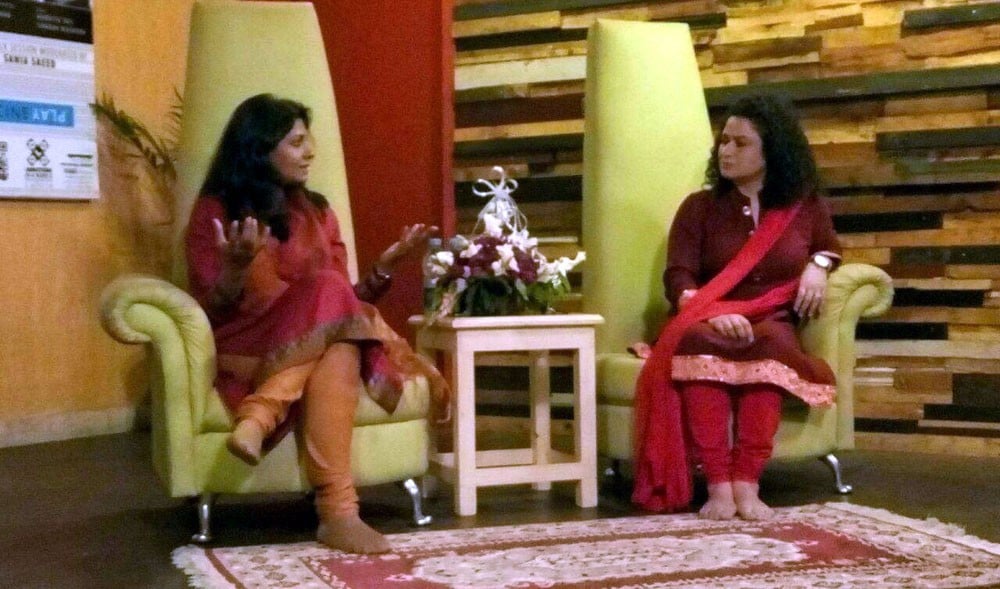
Nandita Das is known for challenging conventions through her work, and the cineplay she recently brought to Lahore was no exception

Media houses around the world are aware that they must find novel ways of garnering the interest of audiences in today’s digitalised global village. Recently, Lahore was the venue of a similar exercise in theatrical innovation when Olomopolo screened Nandita Das’s cineplay, titled Between The Lines, at their Muslim Town studio.
Das is an acclaimed actor and social activist best known to Pakistanis as the female lead in 1947 Earth and the Indian screen adaptation of Bapsi Sidhwa’s novel The Ice-candy Man. Famous for her passionate commitment to social causes, Das has also been bestowed with numerous national and international awards including the prestigious Chevalier of the Order of Arts and Letters by the French government. She is known for challenging conventions through her work, and the cineplay that brought her to Lahore was no exception.
Originally a stage production, Between The Lines was converted into a cineplay by first time producer-actor Subodh Maskara, also Das’s real-life husband. Maskara plays the uber-successful lawyer-husband opposite her in this story about the subtle inequalities women experience in urban Indian society.
Art, and human experiences, know no borders. Peace projects often highlight the similarities between Indian and Pakistani societies, and though the script originally held up the mirror to Indian audiences, the storyline could just as well have been an observation of Pakistani society. The play exposes the multiple layers of gender inequality that have become embedded into our cultures’ patriarchal structures. Maya is the multitasking urban woman trying to create the perfect balance between her personal and professional lives. But these two spheres of her life collide when she decides to represent the same woman her husband is prosecuting. Representing a poor disadvantaged woman in court triggers Maya’s journey of self-realisation.
The dialogues are pithy and portray the ambiguities in the relationships of urban couples very well. The script juxtaposes the personal struggles of two women from different ends of the economic spectrum and highlights the universality of their problems. The play does not simply put the onus on the patriarchal nature of society that trivializes women. It also highlights the manner in which the prevalent mindset of society has conditioned women to view themselves.
While answering questions after the screening, Nandita Das reiterated the point that "women need to be kinder to women".
It is interesting to learn that the storyline is inspired by Das’s personal struggle to maintain a balance after the birth of her son. The internalisation of guilt that she so subtly depicts through the character of Maya is something she herself experienced and sums up the dilemma of modern-day women everywhere when Maya realises that it sounds like "All I want is everything."
The dilemma of women from affluent families is that the discrimination is so subtly ‘spread between the lines’ that it cannot be pinpointed. The contrast is provided by Maskara’s turn as the suave Shankar.
At no point in the play, does this become apparent that this is Maskara’s first theatrical and acting venture. A recurrent theme in the play is the way in which the expression of emotions is frowned upon in our times. The insistence on viewing everything through the prism of cold hard facts is sometimes too dismissive and can lead to a one-sided picture of social issues. The current debate in Pakistan over the execution of Shafqat Hussain illustrates a similar inability of differing camps to reconcile a humane perspective with the legality of the criminal justice system. Maya’s attempt to blur the line of division between these two viewpoints and deliver justice to a falsely accused woman is just another facet of the play from across the border.
The fact that Lahorites were able to view a theatrical production that was originally staged in another country a few years ago is one of the hallmarks of the cineplay genre. An initiative of Subodh Maskara, cineplay aims to capture the essence of theatre and make the experience accessible to audiences irrespective of geographical and time restraints. By combining the stylistic techniques of theatre and the cinematic medium, this innovative idea is transcending cultural and language barriers.
An important objective of this genre is to preserve and archive outstanding theatrical productions for posterity. The possible use of subtitles in the cineplay will go a long way towards promoting cross-cultural and inter-regional peace efforts.
At the event, Das recognised that the cineplay model has found critics as well as supporters. For the purists, cineplays might ruin the traditional art form and discourage theatre-goers. But the fact that Between The Lines has been staged in numerous cities after the screening of the cineplay is a sign of hope for Das and her team and augurs well for this new genre of entertainment.